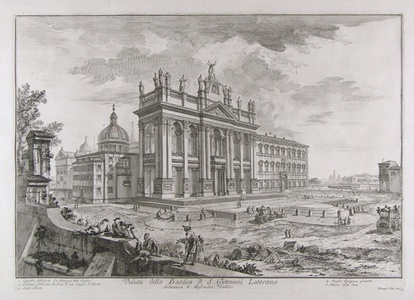| Method | Etching |
| Artist | Giovanni Battista Piranesi |
| Published | Piranesi del. Scol. [Rome, 1749] |
| Dimensions | Image 370 x 540 mm, Plate 390 x 545 mm, Sheet 550 x 760 mm |
| Notes |
Inscription to either side of title reads: '1. Capella fabricata da Clemente XII. Corsini. 2. Palazzo fabricato da Sisto V. ora Conser. di Zitelle. 3. Scala Santa. 4. Guglia Egiziaca giacente. 5. Mura della Citta' A rare first state impression of Piranesi's view of the Basilica of St John Lateran. The facade of the Lateran Basilica is shown in wide view. The open courtyard before the church is occupied by two horse drawn carriages, as well as groups of ambling tourists, and a group of beggars sit atop the city wall in the foreground. The numbered inscription below the image indicates important aspects of the basilica, including the chapel of Pope Clement XII, the Palace of Pope Sixtus V, the Holy Stairs, and the obelisk of Thutmoses IV. The Papal Archbasilica of St John in the Lateran is the seat of the Pope as Bishop of Rome, and both oldest and foremost of the Papal Basilicae. The current church stands on the site of the cavalry camp of the Roman imperial bodyguard, which was demolished by Constantine following his victory over Maxentius in the Battle of the Milvian Bridge. The area in which the Basilica sits was once the property of the gens Laterani, hence its toponym. The church retains a number of interesting architectural features, including the Holy Stairs, allegedly the original marble steps of the Palace of Pontius Pilate, and the obelisk of Thutmoses IV, removed from Karnak and brought to Rome by Constantius II to stand in the Circus Maximus. The Vedute di Roma was Piranesi's most popular and best known series, celebrating the churches, monuments, ruins, bridges, fountains, and public spaces of the city of Rome. The immense popularity of the series meant that they were in constant demand, and Piranesi continued to reissue and add to the series from the 1740s until his death in 1778. The Vedute were particularly popular with British grand tourists, and had a profound effect on the British Neoclassical movement. Demand was such that the series was reprinted numerous times after Piranesi's death, including two Paris editions published by his sons, Francesco and Pietro. Giovanni Battista (also Giambattista) Piranesi (1720 – 1778) was an Italian artist famous for his etchings of Rome and of fictitious and atmospheric "prisons" (the Carceri d'Invenzione). He was a major Italian printmaker, architect and antiquarian. The son of a Venetian master builder, he studied architecture and stage design, through which he became familiar with Illusionism. During the 1740's, when Rome was emerging as the centre of Neoclassicism, Piranesi began his lifelong obsession with the city's architecture. He was taught to etch by Giuseppe Vasi and this became the medium for which he was best known. Hind 8. i/vi, Wilton-Ely 139, Focillon 790, C694 Condition: Strong, clean impression with full margins. Central vertical crease. |
| Framing | framed |
| Price | £2,000.00 |
| Stock ID | 40155 |

